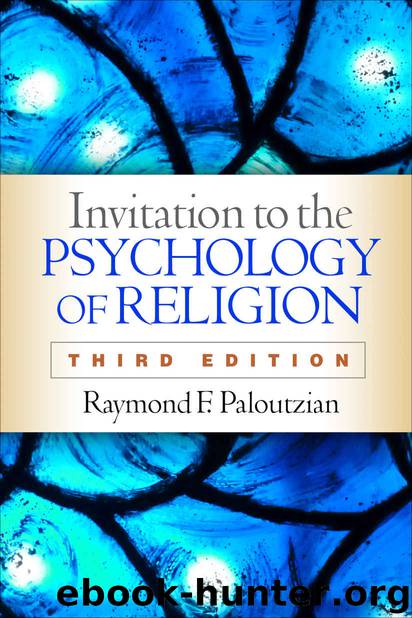Invitation to the Psychology of Religion, Third Edition by Raymond F. Paloutzian

Author:Raymond F. Paloutzian
Language: eng
Format: mobi
Publisher: Guilford Publications
Published: 2016-10-10T04:00:00+00:00
7. Conversion, Deconversion, and Spiritual Transformation 217
sufficient to lead the best life they can personally; the other half think they also must bring others into their religion (WIN/Gallup International, 2012; see also Chapter 1). This means that among U.S. adults alone, about 65
million people are aiming to convert you to join them.
For most would-be converters, the goal is to induce a religious change
in individuals. But for about 6% of U.S. adults, the goal includes “converting” the whole society so that all of it conforms to their beliefs and practices (Newport, 2007). This means that for this small minority, the goal is to create a theocracy, something fundamentally contrary to most modern
governing systems and the laws and liberties in all modern free countries.
The Definition Issue: The What and How of Conversion
There has been incomplete consensus on defining religious conversion.
What often comes to mind is the stereotype of a sudden and total trans-
formation, such as that of the Christian Saint Paul as depicted in the New Testament. Saul of Tarsus was on his way to Damascus, saw a bright light, heard a voice he deemed to be that of Jesus telling him to stop persecuting Christians; he immediately dedicated his life to being a Christian apostle and later wrote about half of the New Testament. Although such a total
turnover is sometimes regarded as the “true” kind of conversion, it is
extremely rare. It is a mistake to think spiritual transformations are fundamentally all the same, that they occur to the same degree, and that the story of Paul is the gold standard for them. In fact, a conversion isn’t limited to a single event but is better seen as a process (Paloutzian, Richardson, & Rambo, 1999).
Content or Process?
Paul’s example includes both the content of the conversion and the pro-
cess by which it occurs. Early attempts to understand religious conversion psychologically categorized areas of life that undergo transformation and various modes of the conversion process but fell short of untangling them.
For example, Thouless (1971) distinguished among intellectual, moral, and social conversions. Intellectual conversions are thought- mediated changes in the content of what someone believes; moral conversions are changes in one’s motivation toward morally relevant behavior; social conversions are changes in one’s actions toward the social environment and issues. The
recent development of the psychology of morality1 (Haidt, 2007, 2008,
2010) is in part a modern intellectual descendent of such distinctions. The 1 The area of the psychology of morality is often called “moral psychology,” but that is an unfortunate misnomer because morality is not a property of psychology as a science, but of people.
218
I I. su bsta N t I v e a R e a s
use of three types to characterize conversion illustrates that the facets of conversion can be differentiated along the important life domains of belief, motivation, and action, paralleling some of Glock’s dimensions of religiousness (Chapter 1). Changes in these facets are not mutually exclusive; changes in one area can, but do not always, accompany changes in others. Separating these facets of
Download
This site does not store any files on its server. We only index and link to content provided by other sites. Please contact the content providers to delete copyright contents if any and email us, we'll remove relevant links or contents immediately.
The Lost Art of Listening by Michael P. Nichols(6472)
Why I Am Not A Calvinist by Dr. Peter S. Ruckman(3769)
The Rosicrucians by Christopher McIntosh(3049)
Wicca: a guide for the solitary practitioner by Scott Cunningham(2704)
Signature in the Cell: DNA and the Evidence for Intelligent Design by Stephen C. Meyer(2501)
Real Sex by Lauren F. Winner(2474)
The Holy Spirit by Billy Graham(2416)
To Light a Sacred Flame by Silver RavenWolf(2353)
The End of Faith by Sam Harris(2288)
The Gnostic Gospels by Pagels Elaine(2026)
Nine Parts of Desire by Geraldine Brooks(2006)
Waking Up by Sam Harris(1958)
Heavens on Earth by Michael Shermer(1955)
Devil, The by Almond Philip C(1899)
Jesus by Paul Johnson(1887)
The God delusion by Richard Dawkins(1848)
Kundalini by Gopi Krishna(1824)
Chosen by God by R. C. Sproul(1760)
The Nature of Consciousness by Rupert Spira(1689)
